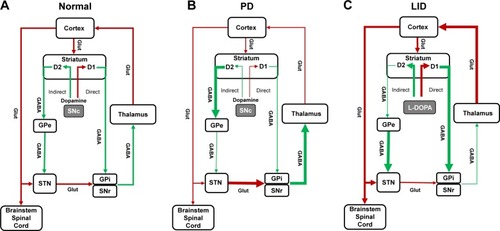Figures & data
Figure 1 Classic basal ganglia model representing (A) normal condition, (B) Parkinson’s disease, and (C) Parkinson’s disease with LID.
Abbreviations: GABA, γ-aminobutyric acid; GPe, globus pallidus externa; GPi, globus pallidus interna; L-DOPA, levodopa; LID, levodopa-induced dyskinesia; PD, Parkinson’s disease; SNc, substantia nigra pars compacta; SNr, substantia nigra pars reticulata; STN, subthalamic nucleus.

Table 1 Summary of therapeutic trials for amantadine extended-release capsules
Table 2 Summary of most common AEs for amantadine extended-release capsules
